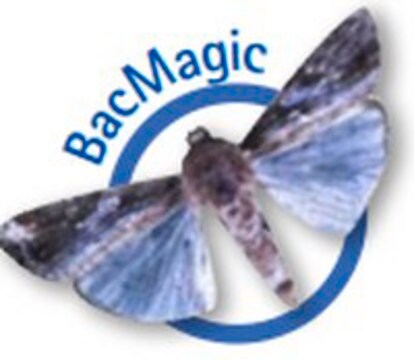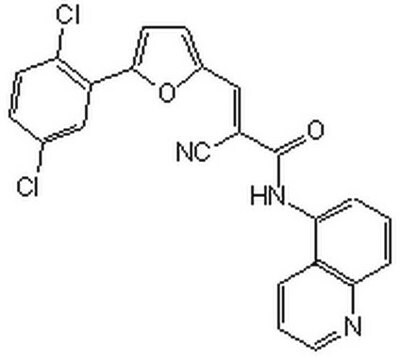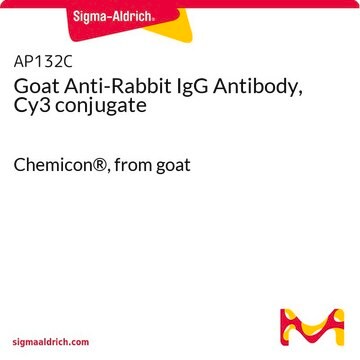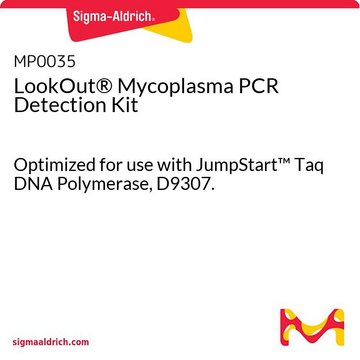C2306
Anti-Rabbit IgG (whole molecule), F(ab′)2 fragment–Cy3 antibody produced in sheep
affinity isolated antibody, buffered aqueous solution
Synonim(y):
Anty-Rabbit IgG Cy3, Cy3 IgG przeciw królikowi
Zaloguj sięWyświetlanie cen organizacyjnych i kontraktowych
About This Item
Polecane produkty
pochodzenie biologiczne
sheep
białko sprzężone
CY3 conjugate
forma przeciwciała
affinity isolated antibody
rodzaj przeciwciała
secondary antibodies
klon
polyclonal
Formularz
buffered aqueous solution
reaktywność gatunkowa
rabbit
metody
immunohistochemistry (formalin-fixed, paraffin-embedded sections): 1:100
Warunki transportu
wet ice
temp. przechowywania
2-8°C
docelowa modyfikacja potranslacyjna
unmodified
Powiązane kategorie
Opis ogólny
Anti-Rabbit IgG (whole molecule), F(ab′)2 fragment–Cy3 antibody produced in sheep binds to all rabbit Igs and is useful when trying to avoid background staining due to the presence of Fc receptors.
The monomeric structure of immunoglobulin G (IgG) consists of two identical heavy chains and two identical light chains with molecular weight of 50kDa and 25kDa, respectively. The primary structure of this antibody also contains disulfide bonds involved in linking the two heavy chains, linking the heavy and light chains and resides inside the chains. IgG is further subdivided into four classes namely, IgG1, IgG2, IgG3, and IgG4 with different heavy chains, named γ1, γ2, γ3, and γ4, respectively. Limited digestion using papain cleaves the antibody into three fragments, two of which are identical and contain the antigen-binding activity (Fab fragments).
Zastosowanie
Anti-Rabbit IgG (whole molecule), F(ab′)2 fragment-Cy3 antibody produced in sheep may be used for immunohistochemistry at a dilution of 1:100 and for immunocytochemistry.
Działania biochem./fizjol.
IgG antibody subtype is the most abundant of serum immunoglobulins of the immune system. It is secreted by B cells and is found in blood and extracellular fluids and provides protection from infections caused by bacteria, fungi and viruses. Maternal IgG is transferred to fetus through the placenta that is vital for immune defense of the neonate against infections. The coupling of Cy3 to Anti-Rabbit IgG (whole molecule), F(ab′)2 fragment antibody allows for the visualization of proteins by fluorescent microscopy.
Postać fizyczna
Solution in 0.01 M phosphate buffered saline, pH 7.4, containing 1% bovine serum albumin and 15 mM sodium azide
Informacje prawne
Cy is distributed under license from Amersham Biosciences Limited.
Oświadczenie o zrzeczeniu się odpowiedzialności
Unless otherwise stated in our catalog or other company documentation accompanying the product(s), our products are intended for research use only and are not to be used for any other purpose, which includes but is not limited to, unauthorized commercial uses, in vitro diagnostic uses, ex vivo or in vivo therapeutic uses or any type of consumption or application to humans or animals.
Ta strona może zawierać tekst przetłumaczony maszynowo.
Nie możesz znaleźć właściwego produktu?
Wypróbuj nasz Narzędzie selektora produktów.
Kod klasy składowania
10 - Combustible liquids
Klasa zagrożenia wodnego (WGK)
nwg
Temperatura zapłonu (°F)
Not applicable
Temperatura zapłonu (°C)
Not applicable
Wybierz jedną z najnowszych wersji:
Masz już ten produkt?
Dokumenty związane z niedawno zakupionymi produktami zostały zamieszczone w Bibliotece dokumentów.
Klienci oglądali również te produkty
Joseph Cellini et al.
Autonomic neuroscience : basic & clinical, 160(1-2), 69-81 (2010-11-16)
Delayed gastric emptying and autonomic neuropathy have been documented in patients with diabetes mellitus. Some medications used to treat delayed gastric emptying enhance release of acetylcholine from autonomic neurons to strengthen gastric contractions. Autonomic coordination among gastric regions may be
Immunobiology (2001)
Pradeep K Shukla et al.
BMC cancer, 16, 189-189 (2016-03-10)
Alcohol consumption is one of the major risk factors for colorectal cancer. However, the mechanism involved in this effect of alcohol is unknown. We evaluated the effect of chronic ethanol feeding on azoxymethane and dextran sulfate sodium (AOM/DSS)-induced carcinogenesis in
A Lu et al.
Gene therapy, 15(15), 1116-1125 (2008-05-30)
In an attempt to determine whether muscle-derived stem cells are distinct from satellite cells, we investigated whether muscle-derived stem cells could be isolated from the skeletal muscle of Pax7-deficient mice, which have been shown to be devoid of or to
Rangarajan Parakalan et al.
BMC neuroscience, 13, 64-64 (2012-06-16)
Microglia, the resident immune cells of the central nervous system (CNS), have two distinct phenotypes in the developing brain: amoeboid form, known to be amoeboid microglial cells (AMC) and ramified form, known to be ramified microglial cells (RMC). The AMC
Nasz zespół naukowców ma doświadczenie we wszystkich obszarach badań, w tym w naukach przyrodniczych, materiałoznawstwie, syntezie chemicznej, chromatografii, analityce i wielu innych dziedzinach.
Skontaktuj się z zespołem ds. pomocy technicznej













